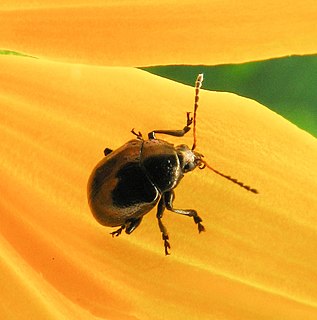
The Donaciinae, aquatic leaf beetles, are a subfamily of the leaf beetle family Chrysomelidae, characterised by distinctly long antennae. They are found in mainly the Holarctic, with very few species in the Southern Hemisphere.

Cassida is a large Old World genus of tortoise beetles in the subfamily Cassidinae. Several species of Cassida are important agricultural pests, in particular C. vittata and C. nebulosa on sugar beet and spinach. The thistle tortoise beetle has been used as a biological control agent against Canada thistle.
Chaetocnema rileyi, the Boca Chica flea beetle, is a species of flea beetle in the family Chrysomelidae. It is found in North America.
Metachroma suturale is a species of leaf beetle. It is found in the United States, ranging from Arizona to Texas. Its length is between 4.8 and 6.4 mm.
Metachroma orientale is a species of leaf beetle. It is found in coastal states in the United States, ranging from Texas to Florida to Massachusetts. Its length is between 3.5 and 4.7 mm.
Paria opacicollis, the oak parium, is a species of leaf beetle. It is found in North America.
Metachroma angustulum is a species of leaf beetle. It is found in the United States.
Promecosoma inflatum is a species of leaf beetle. It is found in Mexico, as well as in Arizona in the United States.
Promecosoma is a genus of leaf beetles in the subfamily Eumolpinae. There are 26 described species in Promecosoma. Most species are found in Mexico, though two species are also known from southern Arizona.

Tymnes is a genus of leaf beetles in the subfamily Eumolpinae. It is known from North America and Central America. There are at least nine described species in Tymnes.
Tymnes oregonensis is a species of leaf beetle. It is found in North America.
Rhabdopterus weisei is a species of leaf beetle. It is found in North America. It was originally described under the name Colaspis subaenea by the American entomologist Charles Frederic August Schaeffer in 1919. However, this name was already used for a species described by Martin Jacoby in 1890, so Schaeffer renamed his species to Colaspis weisei the following year. It was later moved to the genus Rhabdopterus by Herbert Spencer Barber in 1943.
Chrysodinopsis is a genus of leaf beetles in the subfamily Eumolpinae. It was first described by the Czech entomologist Jan Bechyné in 1950. There are two described species in Chrysodinopsis. Both species are found in Mexico, though C. basalis is also found in southern Arizona in the United States. The genus is possibly synonymous with Brachypnoea.
Xanthonia dentata is a species of leaf beetle. Its range spans Arizona, Colorado, New Mexico and Texas, and possibly Kansas. It is associated with oaks.
Metaparia is a genus of leaf beetles in the subfamily Eumolpinae. There are 12 described species in Metaparia, from North America and Central America.
Paria quadrinotata is a species of leaf beetle. It is found in North America.
Graphops is a genus of leaf beetles in the subfamily Eumolpinae. There are 19 described species in Graphops, all from North America. Most species have limited flight capabilities, due to poorly developed wings, and at least one species is known to be flightless.

Brachypnoea puncticollis, the rose leaf beetle, is a species of leaf beetle. It is found in North America.
Colaspis nigrocyanea is a species of leaf beetle from North America. It is distributed in Arizona and Mexico. It was first described by the British entomologist George Robert Crotch in 1873.
Metachroma longicolle is a species of leaf beetle. It is found in the United States and Mexico. Its length is between 2.4 and 3.4 mm.



